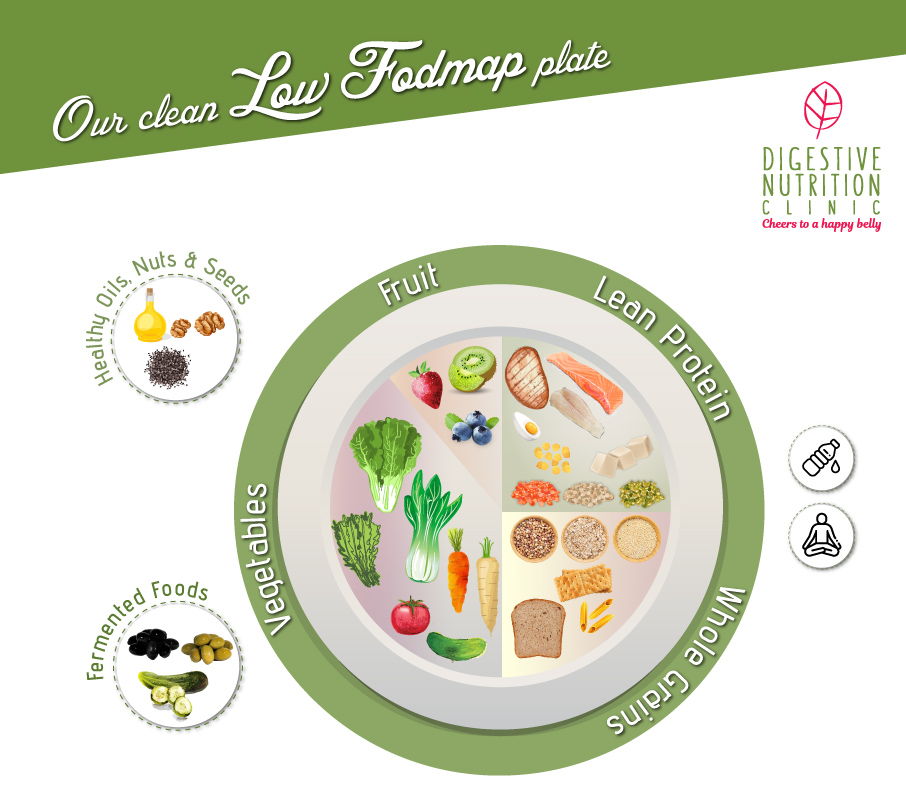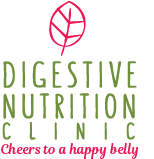As part of our efforts to promote digestive health and nutrition, our team has developed a unique Clean Low FODMAP Diet (with a Mediterranean twist), which incorporates a great variety of foods to your daily diet and helps you maximize your fiber intake.
This diet relies on whole grains and natural sugars and minimizes the consumption of over-processed foods that contain preservatives and additives. Our recipes use plenty of olive oil, vegetables, legumes (as much as is allowed by Monash FODMAPs), olives, fruits, whole grains and lean protein sources. We also try to choose foods that are free of chemical flavorings, artificial colors, antibiotics and pesticides, and minimize your daily salt intake.
Our Clean Low FODMAP approach proposes the following based on Our Clean Low FODMAP Plate.

Vegetables
- Eat more vegetables and aim for variety of low FODMAP vegetables during the day.
Fruit
- Limit one portion of low FODMAP fruit per meal.
- Aim for variety of low FODMAP fruits during the day.
- Limit concentrated sources of fruit, such as dried fruit and fruit juices.
Grains
- Choose unprocessed whole grain/pseudograin products. Whole grains do not cause a spike effect in blood sugar and insulin after consumption and are therefore a better option than white refined grains. Choose quinoa, buckwheat, teff, sorghum, and oats.
Proteins from animal sources
- Choose sustainable fish, eggs and poultry and limit red meat (beef, pork and lamb).
- Avoid processed meats (deli, bacon, sausages and hot dogs).
- Choose to eat pastured eggs.
- Aim to consume meat derived from 100% grass-fed animals and not from animals raised in animal feeding operations where they are often fed antibiotics at low doses in order to promote growth.
- Choose low fat, dairy options (lactose free if you cannot tolerate lactose).
- Choose sustainable fish that lives in non-polluted waters. Avoid fish bred in aquaculture environments where they are also exposed to low levels of antibiotics for growth.
- As a general rule of thumb, bear in mind that the bigger the fish the longer it has lived, so the longer time it has had to accumulate toxins from the sea or ocean. Small wild-caught fish such s sardines, anchovies and herring are good examples of fish with a lower contamination risk and are great choices for seafood.
Proteins from plant sources
- Consume seeds and nuts low in FODMAPs and also free of sulphites as a preservative.
- Choose organic firm tofu and tempeh.
- Go for these tested low FODMAP legumes in their recommended low FODMAP servings (use the Monash FODMAP app for reference):
- Chana dal, boiled
- Urid dal, boiled
- Lentils, canned/preferably in carton
- Lentils green or red, boiled
- Mung beans, sprouted
- Edamame, frozen
- Chickpeas canned/preferably in carton
Oils
- Use cold-pressed healthy oils instead of animal fats.
- We recommend the use of a good quality extra virgin olive oil.
- Due to its high saturated fat content, use virgin coconut oil only occasionally & not as an everyday staple.
- Limit butter to occasional use.
- Avoid partially hydrogenated oils.
Fermented foods
- Don’t forget to eat foods containing probiotics (good bacteria for the gut).
- We encourage you to choose these low FODMAP options: lactose-free yoghurt, lactose-free kefir, olives, pickles, tempeh, and sauerkraut (low FODMAP portion is 1 tablespoon).
References
Cozma-Petruţ A, Loghin F, Miere D, Dumitraşcu DA. (2017) Diet in irritable bowel syndrome: What to recommend, not what to forbid to patients! World J Gastroenterol; 23(21):3771-3783.
Schumann D, Langhorst J, Dobos G, Cramer H. (2018) Randomised clinical trial: yoga vs a low-FODMAP diet in patients with irritable bowel syndrome. Aliment Pharmacol Ther; 47(2):203-21
Raehsler SL, Choung RS, Marietta EV, Murray JA. (2018) Accumulation of Heavy Metals in People on a Gluten-Free Diet. Clin Gastroenterol Hepatol; 16(2):244-251.
McCarthy, Claire, MD. 3 reasons your child shouldn't go "gluten-free" (unless your doctor says so). Harvard Health Blog, June 7, 2016.
McCarthy, Claire, MD. FDA warns parents about arsenic in rice cereal. Harvard Health Blog, April 5, 2016.
Love DC, Rodman S., Neff RA, Nachman KE. (2011) Veterinary Drug Residues in Seafood Inspected by the European Union, United States, Canada and Japan from 2000 to 2009. Environ Sci Technol; 45(17):7232-7240.
Friesen EN, Ikonomou MG, Higgs DA, Ang KP, Dubetz C. (2008) Use of Terrestial Based Lipids in
Aquaculture Feeds and the Effects on Flesh Organohalogen and Fatty Acid Concentrations and Farmed Atlantic Salmon. Environ Sci Technol; 42(10):3519-3523.
Hites RA, Foran JA, Schwager SJ, Knuth BA, Hamilton MC, Carpenter DO. (2004) Global Assessment of Polybrominated Diphenyl Ethers in Farmed and Wild Salmon. Environ Sci Technol; 38(19):4943-4949.
Foran JA, Hites RA, Carpenter DO, Hamilton MC, Mathews-Amos A, Schwager SJ. (2004) A Survey of Metals in Tissues of Farmed Atlantic and Wild Pacific Salmon. Environ Toxicol Chem; 23(9):2108-2110.
U.S. Department of Agriculture, USDA: USDA Graded Cage-Free Eggs: All They're Cracked Up To Be
Environmental Working Group
Monterey Bay Aquarium Foundation
2015-2020 Dietary Guidelines for Americans
2017 EPA-FDA Advice about Eating Fish and Shellfish
Dartmouth University's Toxic Metals Superfund Research Program. Arsenic and You project.
King's College London FODMAP website.
Monash FODMAP website.


